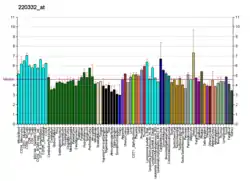| CLDN16 | |||||||||||||||||||||||||||||||||||||||||||||||||||
|---|---|---|---|---|---|---|---|---|---|---|---|---|---|---|---|---|---|---|---|---|---|---|---|---|---|---|---|---|---|---|---|---|---|---|---|---|---|---|---|---|---|---|---|---|---|---|---|---|---|---|---|
| Identifiers | |||||||||||||||||||||||||||||||||||||||||||||||||||
| Aliases | CLDN16, HOMG3, PCLN1, claudin 16 | ||||||||||||||||||||||||||||||||||||||||||||||||||
| External IDs | OMIM: 603959 MGI: 2148742 HomoloGene: 4799 GeneCards: CLDN16 | ||||||||||||||||||||||||||||||||||||||||||||||||||
| |||||||||||||||||||||||||||||||||||||||||||||||||||
| |||||||||||||||||||||||||||||||||||||||||||||||||||
| |||||||||||||||||||||||||||||||||||||||||||||||||||
| |||||||||||||||||||||||||||||||||||||||||||||||||||
| |||||||||||||||||||||||||||||||||||||||||||||||||||
| Wikidata | |||||||||||||||||||||||||||||||||||||||||||||||||||
| |||||||||||||||||||||||||||||||||||||||||||||||||||
Claudin-16 is a protein that in humans is encoded by the CLDN16 gene.[5][6] It belongs to the group of claudins.
Tight junctions represent one mode of cell-to-cell adhesion in epithelial or endothelial cell sheets, forming continuous seals around cells and serving as a physical barrier to prevent solutes and water from passing freely through the paracellular space. These junctions are composed of sets of continuous networking strands in the outwardly facing cytoplasmic leaflet, with complementary grooves in the inwardly facing extracytoplasmic leaflet. The protein encoded by this gene, a member of the claudin family, is an integral membrane protein and a component of tight junction strands. It is found primarily in the kidneys, specifically in the thick ascending limb of Henle, where it acts as either an intercellular pore or ion concentration sensor to regulate the paracellular resorption of magnesium ions. Defects in this gene are a cause of primary hypomagnesemia, which is characterized by massive renal magnesium wasting with hypomagnesemia and hypercalciuria, resulting in nephrocalcinosis and kidney failure.[6]
References
- 1 2 3 GRCh38: Ensembl release 89: ENSG00000113946 - Ensembl, May 2017
- 1 2 3 GRCm38: Ensembl release 89: ENSMUSG00000038148 - Ensembl, May 2017
- ↑ "Human PubMed Reference:". National Center for Biotechnology Information, U.S. National Library of Medicine.
- ↑ "Mouse PubMed Reference:". National Center for Biotechnology Information, U.S. National Library of Medicine.
- ↑ Simon DB, Lu Y, Choate KA, Velazquez H, Al-Sabban E, Praga M, Casari G, Bettinelli A, Colussi G, Rodriguez-Soriano J, McCredie D, Milford D, Sanjad S, Lifton RP (Jul 1999). "Paracellin-1, a renal tight junction protein required for paracellular Mg2+ resorption". Science. 285 (5424): 103–6. doi:10.1126/science.285.5424.103. PMID 10390358.
- 1 2 "Entrez Gene: CLDN16 claudin 16".
External links
- Human CLDN16 genome location and CLDN16 gene details page in the UCSC Genome Browser.
Further reading
- Kniesel U, Wolburg H (2000). "Tight junctions of the blood–brain barrier". Cell. Mol. Neurobiol. 20 (1): 57–76. doi:10.1023/A:1006995910836. PMID 10690502. S2CID 26473781.
- Heiskala M, Peterson PA, Yang Y (2001). "The roles of claudin superfamily proteins in paracellular transport". Traffic. 2 (2): 93–8. doi:10.1034/j.1600-0854.2001.020203.x. PMID 11247307. S2CID 12132159.
- Tsukita S, Furuse M, Itoh M (2001). "Multifunctional strands in tight junctions". Nat. Rev. Mol. Cell Biol. 2 (4): 285–93. doi:10.1038/35067088. PMID 11283726. S2CID 36524601.
- Tsukita S, Furuse M (2003). "Claudin-based barrier in simple and stratified cellular sheets". Curr. Opin. Cell Biol. 14 (5): 531–6. doi:10.1016/S0955-0674(02)00362-9. PMID 12231346.
- González-Mariscal L, Betanzos A, Nava P, Jaramillo BE (2003). "Tight junction proteins". Prog. Biophys. Mol. Biol. 81 (1): 1–44. doi:10.1016/S0079-6107(02)00037-8. PMID 12475568.
- Manz F, Schärer K, Janka P, Lombeck J (1978). "Renal magnesium wasting, incomplete tubular acidosis, hypercalciuria and nephrocalcinosis in siblings". Eur. J. Pediatr. 128 (2): 67–79. doi:10.1007/BF00496992. PMID 668721. S2CID 11806270.
- Weber S, Hoffmann K, Jeck N, et al. (2000). "Familial hypomagnesaemia with hypercalciuria and nephrocalcinosis maps to chromosome 3q27 and is associated with mutations in the PCLN-1 gene". Eur. J. Hum. Genet. 8 (6): 414–22. doi:10.1038/sj.ejhg.5200475. PMID 10878661.
- Weber S, Schneider L, Peters M, et al. (2001). "Novel paracellin-1 mutations in 25 families with familial hypomagnesemia with hypercalciuria and nephrocalcinosis". J. Am. Soc. Nephrol. 12 (9): 1872–81. doi:10.1681/ASN.V1291872. PMID 11518780.
- Strausberg RL, Feingold EA, Grouse LH, et al. (2003). "Generation and initial analysis of more than 15,000 full-length human and mouse cDNA sequences". Proc. Natl. Acad. Sci. U.S.A. 99 (26): 16899–903. Bibcode:2002PNAS...9916899M. doi:10.1073/pnas.242603899. PMC 139241. PMID 12477932.
- Müller D, Kausalya PJ, Claverie-Martin F, et al. (2004). "A Novel Claudin 16 Mutation Associated with Childhood Hypercalciuria Abolishes Binding to ZO-1 and Results in Lysosomal Mistargeting". Am. J. Hum. Genet. 73 (6): 1293–301. doi:10.1086/380418. PMC 1180395. PMID 14628289.
- Gerhard DS, Wagner L, Feingold EA, et al. (2004). "The Status, Quality, and Expansion of the NIH Full-Length cDNA Project: The Mammalian Gene Collection (MGC)". Genome Res. 14 (10B): 2121–7. doi:10.1101/gr.2596504. PMC 528928. PMID 15489334.
- Hou J, Paul DL, Goodenough DA (2005). "Paracellin-1 and the modulation of ion selectivity of tight junctions". J. Cell Sci. 118 (Pt 21): 5109–18. doi:10.1242/jcs.02631. PMID 16234325.
- Kausalya PJ, Amasheh S, Günzel D, et al. (2006). "Disease-associated mutations affect intracellular traffic and paracellular Mg2+ transport function of Claudin-16". J. Clin. Invest. 116 (4): 878–91. doi:10.1172/JCI26323. PMC 1395478. PMID 16528408.
- Türkmen M, Kasap B, Soylu A, et al. (2007). "Paracellin-1 gene mutation with multiple congenital abnormalities". Pediatr. Nephrol. 21 (11): 1776–8. doi:10.1007/s00467-006-0247-7. PMID 16924549. S2CID 9410376.
- Liu F, Koval M, Ranganathan S, Fanayan S, Hancock WS, Lundberg EK, Beavis RC, Lane L, Duek P, McQuade L, Kelleher NL, Baker MS (2015). "A systems proteomics view of the endogenous human claudin protein family". J Proteome Res. 15 (2): 339–359. doi:10.1021/acs.jproteome.5b00769. PMC 4777318. PMID 26680015.




